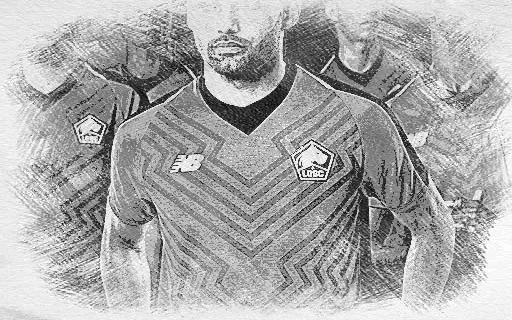
Total Football Journeyman: Total Football on a Budget
So far in my Total Football Journeyman series, I had covered some pretty great historic teams like Ajax, Barcelona, and Liverpool. But I feel that in recounting the stories of these giants, I lost track of something important. All those sides played beautiful fluid football but were already established world-class clubs. Yet the question remains, can a Total Football style be achieved by a club that is good but not world-class? And can Total Football be achieved on a budget? To answer this I will go back in time a decade to 2011. This was the year when Barcelona, Manchester United, and AC Milan were the champions of their respective leagues while a little team called Les Dogues shocked France by breaking the duopoly of Lyon and Marseille. And they did it in style.
Before I had the idea for this article’s topic, I planned to either write about Viktor Maslov’s Dynamo Kiev from 1960s or Brazil’s 1970 World Cup winning team. Maslov’s was a pioneer pressing side with an innovative, for its time, 4-4-2 shape. And the Brazilians, arguably the best team ever assembled. But on second thought I realized that enough has been written about both topics. And Jonathan Wilson did it far better than I ever could in his seminal “Inverting the Pyramid”. In fact, there are whole chapters devoted to both teams in this amazing book. So I decided to look for a Total Football story that did not already have so much coverage.
The French Dark Horse
Also I was looking to emulate a manager who is not as well known as my usual suspects, Guardiola, Cruyff or Bielsa. The name of Rudi Garcia, the current manager of Olympique Lyonnais, came to mind. He does not have many articles written about him although I think he should. Not every manager can boast three French Manager of the Year awards, having achieved one league double and one Europa League runner-up.
It’s a shame because the story of Rudi Garcia’s Lille has all the makings of a blockbuster. What’s more interesting than a story about a team that overcame all odds and were crowned champions of France in 2011? Perhaps a team that played beautifully while operating on a shoestring budget? So lets find out about how that Lille formation worked and about its players. And more importantly lets see how you can play some beautiful Total Football in FM20 without actually being a world-class club.
When Rudi Garcia got the job managing AS Roma, he not only brought his star player Gervinho, but also his title-winning formation. Unfortunately, the 4-3-3 (or 4-1-2-3 DM) that brought a domestic double to Lille and crowned Garcia as the French Manager of the Year was not as successful in the sunny Italian capital. It just goes to show that in real life as in Football Manager, plug-and-play tactics don’t usually work. It is the specific collection of players on the field that makes a successful tactic. The magic formula. So what made that team from the small, cold city in northern France so good?
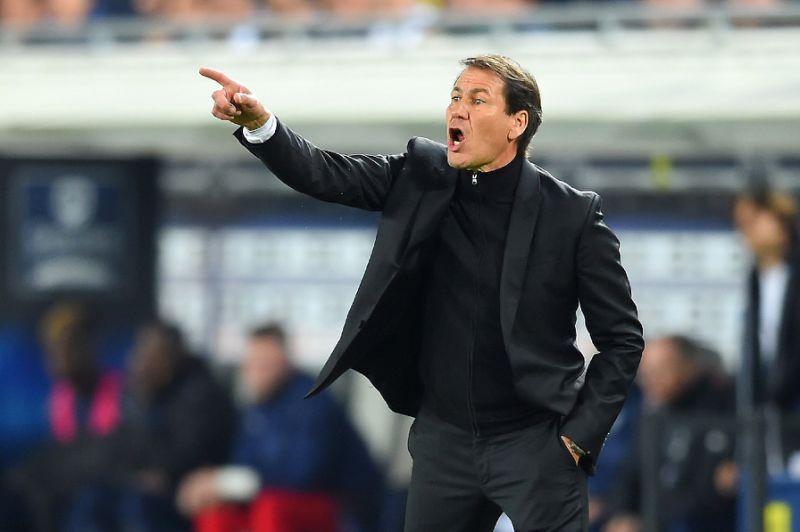
Dynamic Attack
What drew me towards Lille in FM20, was above all its youthful squad full of potential. Wonderkids like Victor Osimhen, Jonathan Ikone and Timothy Weah definitely stand out. They can all develop into world-class player bound to dominate European football for years to come. I am even going to go out on a limb in stating that the current Lille OSC First Teamis better than the one in 2010.
In some positions the current Lille squad mirrors that legendary 2010 side. While in others not so much. For instance, lets look at the central striker position.
In the screen above, you can see Moussa Sow as he appeared in FM12. One year after leaving Lille, he presents a picture of a very physical, yet versatile striker in his prime. These are qualities with which he led the line of attack from his central striker position. The current frontman is Victor Osimhen. He has remarkably similar attribute profile to Sow. But his main advantage is his age. Unlike Sow, he still has plenty of potential to grow into a more complete striker. Below is how Victor looks just a few months into 2019-2020 season. The hints of a well-rounder striker who will be much better than Sow are already starting to show.
On the right Garcia usually used the up-and-coming Ivory Coast star, Gervinho. At 23 years old, he had already reached his prime. Interestingly his attributes have not changed that much over the last 10 years. He is currently terrorizing defenders in Italian Serie A. And still known for his blistering quick acceleration and tricky running. Also due to his excellent ball control, agility and sudden bursts of energy, Garcia had him cutting inside from the right. He also moved centrally to the edge of attack just next to the central striker. This movement coupled with the left winger dropping much deeper into the traditional #10 slot between midfield and attack. It was almost as if Lille transformed into 4-1-2-1-2 when in attacking phase.
Of the current batch of Lille attackers, the one that approaches Gervinho the closest is the wonderkid Jonathan Ikone. The Frenchman, similarly pacey and tricky dribbler, also prefers to cut inside to attack. And he looks like he could become even better than Gervinho. Unlike Gervinho, he is stronger mentally, being a much more hard-working team player. In every one of my previous FM20 saves, he earned a move to a bigger European side within a year. So it will take some effort from you as a manager to keep him at Lille. Just look at those attributes! Jonathan has been been absolutely deadly for us in the Champions League, scoring in big games against Borussia and Barcelona.
Going back to 2010 again, on the left wing, there was of course the boy wonder, Eden Hazard. I do not think I need to say more to introduce him. Except that he was undoubtedly the crowning jewel in that Lille team. Even at 19 year old he was already showing signs of being one in the generation type of talent.
Hazard was touted as some kind of Belgian Messi, especially due to his unbelievable pace, dribbling and creativity. While he never truly developed to the same level as Messi perhaps, he still turned into one of the best attacking playmakers in Europe. Rudi Garcia was very lucky to have his services in that defining season. For as we know in retrospect the diminutive Belgian wonderkid would not stay in France long, moving on to foreign coasts and greater things. Finding his equivalent now will be tricky, but I have a few ideas already.
The Pressing Game and Midfield Trio Roles
As I mentioned earlier, Garcia’s Lille’s played more like a narrow 4-1-2-1-2 (or even 3-2-5 in-possession) than a typical 4-3-3 that it was supposed to be on paper.
This was due to the movement of Eden Hazard, who cut into the zone between the strikers and midfielders. At the same time the right winger, Gervinho moved forward and narrow to join Sow at the front. And the two wingbacks got involved in attack by bombing forward and wide almost like wingers, or old-fashioned Brazilian wingbacks. While Emerson (playing like a true-to-name Brazilian wingback) was probably the more attacking of the two, both him and young Debuchy would often reach the byline and ping crosses and lay-offs to the strikers and central midfielders.
And speaking of the central midfielders, they were key in Garcia’s formation. There was Mavuba – the more defensive holding midfielder and the two supporting midfielders, Cabaye and Balmont. The key aspect of the formation was that when these two more offensive players pushed forward and got involved in high pressing (defending from the front if you will) the defensive holder had to stay back and help the centrebacks. It provided balance in what was otherwise a rather aggressive attacking formation. Something not that different to how the midfield worked in Sarri’s Vertical Tiki Taka at Napoli a decade later.
Thus relatively High Line of Defence and High Engagement Line were essential to Lille’s game plan. It helped that the two central midfielders were very technical. But it was their high workrate that mattered more. So even if they got high up the field, they would also get back when defending. Garcia’s Lille was a very hard-working team. Starting with the forwards and the central midfielders, the whole team pressed hard and tried to meet opposition’s attack high up the field. The pressing started in the opponent’s half. Thus I chose extremely urgent closing down to compliment our High DL and LOE.
As a holding midfielder, Mavuba was hands down the hardest working one. Firstly, he focused on covering the central position in front of and between the central defenders. Such as when the central defenders went high and wide to help support the full-backs. Secondly, he needed to provide a creative link between the defence and midfield, as well as the occasional long ball to the forwards. The main source of verticality in the formation will be coming from this role. Some might think that the half-back role might be more suitable here but I currently prefer the greater creativity that DLP (even on Defend duty) brings to the team. Especially with a player like Xeka in the position.
To me the role of Balmont is better recreated as a dynamic Mezzala, because I envision him as player that needed to get high up to press and support the right fullback. But also he needed to be more pro-active and attack-oriented to help with the attack. He did this by moving into the right half-space and staying closer to the opposition penalty area. A bit like Guardiola’s hybrid Free Eight role.
The Joker
At 2010 Lille, Cabaye was also this type of Free Eight role that created from the front and pressed relentlessly. He was definitely more creative of the two, thus I chose Advanced Playmaker(Attack) to recreate him. Rather than a RPM or DLP. I neither wanted my “Cabaye” player to roam around too much or be too static, holding his position.
Yucuf Yazici, of current Lille squad, was my perfect Cabaye. He already has 5 assists two months into our campaign. And he might have even developed into a better player than Cabaye. Until this happened on one fateful night in October.
I never like to write off a young player due to long-term injury… but 10 months does seem kind of long. Oh well, only time will tell. But for now… Good Bye Yucuf, I hardly even knew you.
So the search is on for Yucuf’s replacement and my “Cabaye” successor. Or do I even need to use a “successor”? Maybe not. Not when the original is still around and kicking.
How was I able to get him third of the way into the season and between the two transfer windows?
French rules allow clubs in Le Championnat to sign a player out of the regular transfer window and this is referred to as a joker – although each club is only allowed one.
Definition of The Joker Transfer Window, Wikipedia
Thank God for The French League 1 Joker Transfer rule, as our season might still turn out alright. So the club legend, Cabaye is back! And just look at those attributes and traits! And besides being a great mentor for the youngsters, he only cost me 1.5 million. Now if only we could somehow get Hazard back, before he completely loses his legs from age.
Total Football on a Budget
So sticking to my original plan, I am trying not to overspend with Lille. 5.5 million so far. Although as you can see, Olympiakos has another 4.5 million owed in 50 games. But I love those kind of transfer clauses since it allows me to control how many games Tsimikas will play, before I need to pay the rest. So essentially I can choose not to pay his full price for another year, or more. So a player like Tsimikas for less than 5 million up front is actually a pretty good deal. Especially if you consider his attributes. This Greek International is probably one of the best cheap Complete Wingback options available at the start of the game.
Results
The far more satisfying part of this equation is in the kinds of results we have been getting after this seemingly meager investment.
I was starting to think that my Borussia victory was going to be the sole highlight in that uber-hard Champions League Group G, but then this happened at Camp Nou, of all places:
And before we knew it, we topped our group and are moving to the next stage. It’s also interesting to note that we finished the match shorthanded after Bamba got a red card in the last 20 minutes. Finally, this goal by the player of the match, Ikone, is probably the finest goal I have seen in all my saves with FM20. Enjoy:
In The Next Article
So in my next update, I will continue to explore how the rest of the current Lille squad measures up to that historic 2010-11 side. I will also expand further on the “Hazard role” and who I see as my best alternative for it. And of course I will show how this recreation of Rudi Garcia’s 4-3-3 tactic holds up for the rest of the season. My objective for this save is simple. Prove that you don’t need to overthink and use a gazillion of team instructions to achieve a fluid, short-passing style. In this, I was inspired by a guy on a forum who while managing FC Kaiserslautern was able to be successful with a simple, hands-off tactical approach. That is by trying to keep the team and player instructions minimal and making no tactical changes, except subs, during matches. So let us see how far it takes Lille.
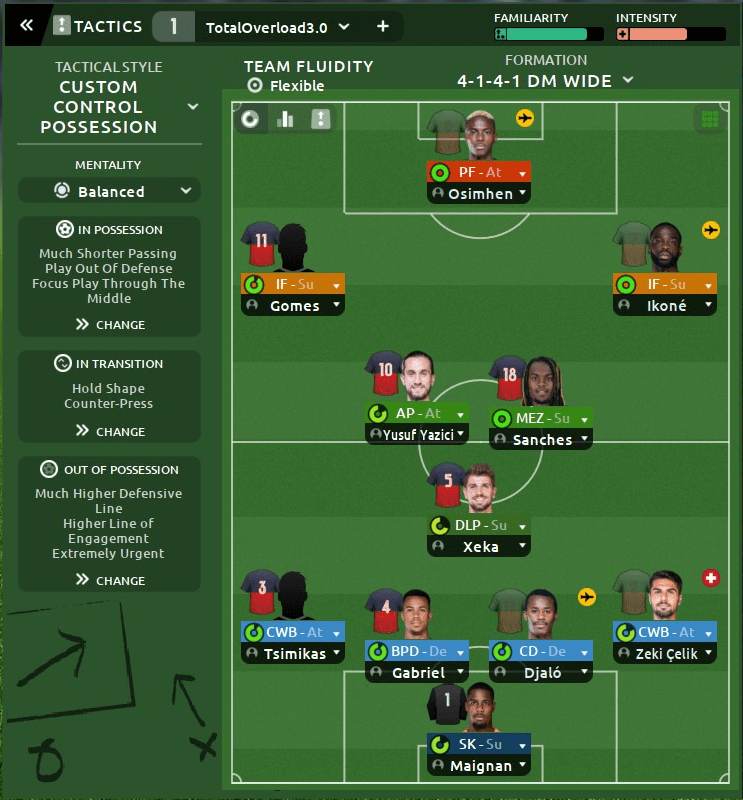
Here is my tactic’a download link for you guys to try: https://ufile.io/2cia078q
So what do you think? Is Total Football possible in FM20 without a budget of Manchester City or without min-maxing every decision like Pep Guardiola? Let me know in the comments below. You can follow us @ Dictate The Game’s Facebook and Dictate The Game’s Twitter. And check out other similar articles:
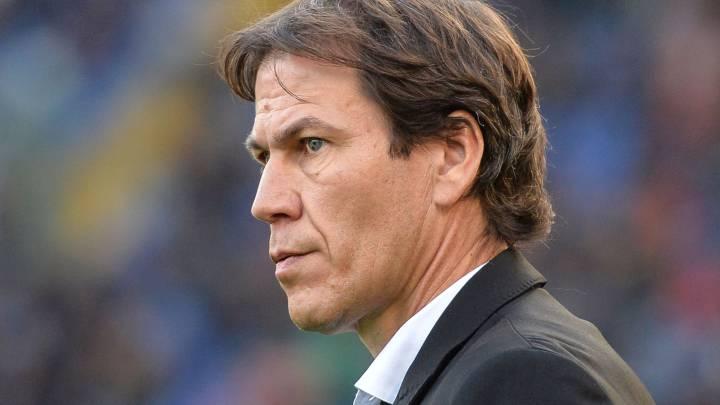
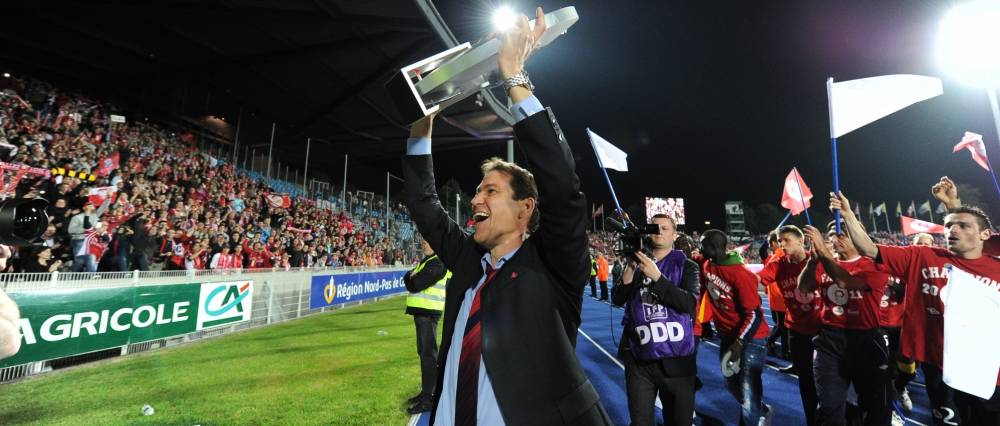

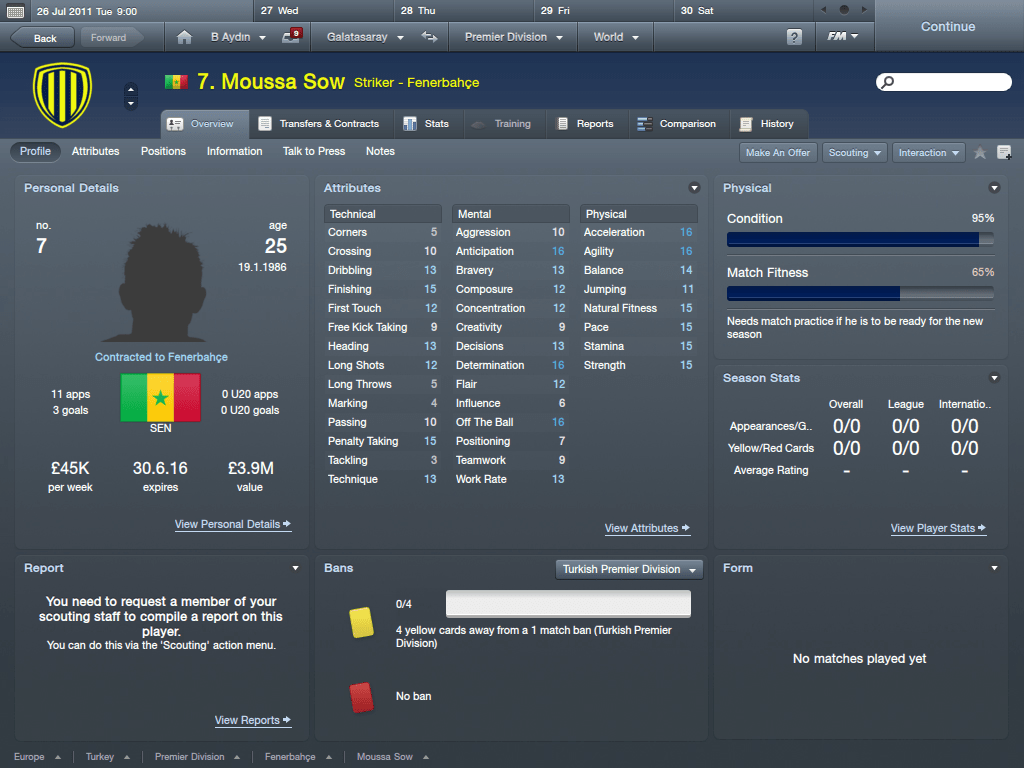















3 thoughts on “Total Football Journeyman: Total Football on a Budget”
Hay. im looking fwd to part 2 of this. im starting a liile save myself.
Haha, I havent written Part 2 yet. Will need to play my save a bit more and get more testing done.
I discovered your blog thanks to your posts on the sigames forums. I’m trying to recreate this with my Rennes squad on FM 20. Too bad that you only made just one entry, it was an amazing reading. By the way, I was addicted to that guy posts on his FC Kaiserslautern. It really changed my whole view of the instructions in the game. His tactic was so “simple” but effective.